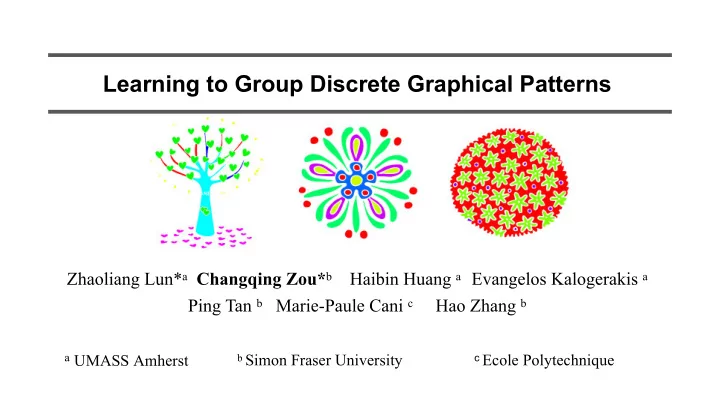

Learning to Group Discrete Graphical Patterns Zhaoliang Lun* a Changqing Zou* b Haibin Huang a Evangelos Kalogerakis a Ping Tan b Marie-Paule Cani c Hao Zhang b a UMASS Amherst b Simon Fraser University c Ecole Polytechnique
Pattern Grouping Problem : motivation Pattern Grouping
Pattern Grouping Problem : motivation Similarity Symmetry Pattern Grouping Continuity & Proximity
Challenges (1) : conflicting grouping principles Symmetry rule wins Input Pattern Similarity rule wins
Challenges (2): various noises
Challenges (2): various noises Inaccurate Symmetry Loose Similarity
Challenges (3): Rich Variations and Complexity
Applications of Pattern Grouping q Pattern Editing Inverse Procedural Modeling by Automatic Generation of L-systems. O. Stava, et al. 2010
Applications of Pattern Grouping q Pattern Editing q Pattern Exploration PATEX: Exploring Pattern Variations. P. Guerrero, et al. 2016
Applications of Pattern Grouping q Pattern Editing q Pattern Exploration q Layout Optimization GACA: Group-Aware Command-based Arrangement of Graphic Elements. P. Xu, et al. 2015
Related Work: Model & Rule Driven q Gestalt-based pattern grouping Ø Conjoining Gestalt Rules for Abstraction of Architectural Drawings. Nan et al. TOG, 2011. Ø Perceptual grouping by selection of a logically minimal model, Feldman, ICCV, 2003. Ø The whole is equal to the sum of its parts: A probabilistic model of grouping by proximity and similarity in regular patterns, Kubovy & Berg. Psychological Review, 2008. q Symmetry-based pattern grouping Ø Folding meshes: hierarchical mesh segmentation based on planar symmetry. Simari et al. SGP, 2006. Ø Co-Hierarchical Analysis of Shape Structures. O. Kaick et al. TOG, 2013. Ø Symmetry Hierarchy of Man-Made Objects. Wang et al. Computer Graphics Forum, CGF, 2011. Ø Layered Analysis of Irregular Facades via Symmetry Maximization. Zhang et al. TOG, 2013.
Related Work : Gestalt-Based Pattern Grouping Group & Simplify Conjoining gestalt rules for abstraction of architectural drawings, Nan et al. TOG, 2011.
Nan’s Strategy: model-driven q Hand-engineering rules to quantify grouping models q Hand-tuning relative importance of rules Nan et al ’s strategy
Our Work: First data-driven approach q Learning to group discrete graphical patterns from human annotations q Loosely consider Gestalt principles q Learn relative importance of features, without hand-engineer rules q Robust noise handling thanks to learning approach Convey
Our Strategy q Learning to group discrete graphical patterns from human annotations q Loosely consider Gestalt principles q Learn relative importance of features, without hand-engineer rules q Robust noise handling thanks to learning approach Generalize (b)
Our Solution: learn features for clustering q Learned feature descriptor for each elements q Clustering in learned feature space
Our Solution: bottom-up strategy q Learned feature descriptor for each elements q Clustering in learned feature space
Our Solution: learn features for clustering q Learned feature descriptor for each elements q Clustering in learned feature space q Not optimize the clustering algorithm itself q Learn a feature space suitable for clustering
Our Solution q Element -> learned feature descriptor q Clustering in learned feature space q Not optimize the clustering algorithm itself q Learn a feature space suitable for clustering
Feature Learning: how do human group
Feature Learning: how do human group Similar & close-by
Feature Learning: how do human group Horizontal Alignment
Feature Learning: how do human group How can we migrate human experience into machine learning?
Feature Learning: local Information ----- Shape-Aware q Similarity q Continuity Context-Aware q Proximity Local Information
Feature Learning: global Information ----- Shape-Aware q Similarity q Continuity Context-Aware q Proximity Local Information q Symmetry ----- Structure-Aware Global Information
Local feature: Atomic Element Encoder
Local feature: Atomic Element Encoder
Local feature: Atomic Element Encoder
Local feature: Structure Encoder
Global feature: Structure Encoder
Network Architecture Atomic element Encoder Structure 45 Encoder 8M training pairs Location & Size 45
Network Architecture Atomic element Encoder Structure 45 Encoder 8M training pairs Location & Size 45
Data Collection: Lack of suitable patterns on the web Black & White Color Gradient Lack Structural Variety
Layout Templates Based Training Data Collection Pattern Examples Layout Template
Training Data : element collection deforming complexing Basic atomic elements adding noises
Training Data Collection q ~800 pattern layout templates q ~8K pattern images q 500 positive and 500 negative pairs of elements q ∼ 8M training pairs
Results on synthesized patterns
Grouping Results on synthesized patterns Clover Arrow
Results on synthesized patterns Noise level increase
Results on downloaded patterns
Results on downloaded patterns
Results on downloaded Challenging patterns
Results on downloaded Challenging patterns
Quantitative Results with various measures and alternatives Greater score mean better grouping results
Quantitative Results with various Clustering Strategies
Results of User Study
Limitation on model Unreasonable grouping results No Semantic knowledge Unreasonable grouping results
Limitation on input data Edge Regions
Future work: Unified Framework for Various types of Input Data
Other Future Directions: Hierarchical Grouping The optimal result
Other Future Directions: learn to rank grouping results Input Grouping (a) Grouping (b) Which Grouping Results is better?
Other Future Directions: learn to rank grouping results Input Grouping (a) Grouping (b) Ranking order Changed
Conclusion q First (data-driven + deep CNN) for discrete 2D patterns . q Learned shape-, context-, and structure-aware descriptors for graphical elements. q A large, annotated dataset is provided online. http://people.cs.umass.edu/~zlun/papers/PatternGrouping/ (source code + dataset)
Conclusion q First (data-driven + deep CNN) for discrete 2D patterns. q Learned shape-, context-, and structure-aware descriptors for graphical elements. q A large, annotated dataset is provided online. http://people.cs.umass.edu/~zlun/papers/PatternGrouping/ (source code + dataset)
Conclusion q First (data-driven + deep CNN) for discrete 2D patterns. q Learned shape-, context-, and structure-aware descriptors for graphical elements. q A large, annotated dataset is provided online. http://people.cs.umass.edu/~zlun/papers/PatternGrouping/ ( source code + dataset )
Acknowledgements q Dr. Ke Li for the help on experimental data preparation. q The Science and Technology Plan Project of Hunan Province . q The Massachusetts Technology Collaborative grant for funding the UMASS GPU cluster. q NSERC Canada. q Gift funds from Adobe Research.
Thanks! Q&A http://people.cs.umass.edu/~zlun/papers/PatternGrouping/ (Source code & Dataset)
Recommend
More recommend